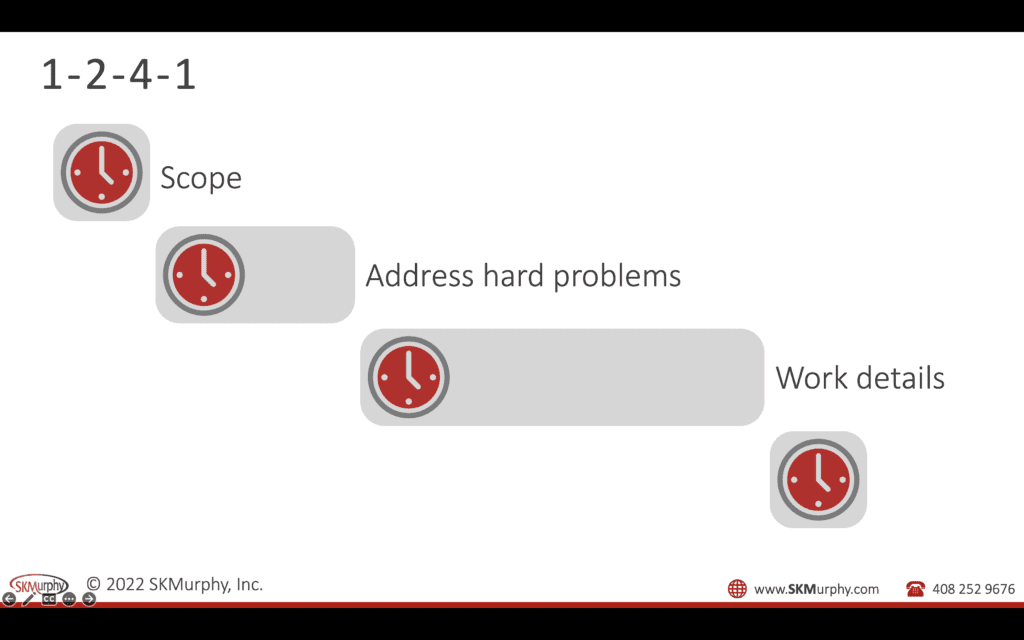We use a four phase project planning model we call 1-2-4-1 which allocates time to planning, prototyping key challenges, finishing the bulk of the work, and polishing.
Chalk Talk: 1-2-4-1
We use a process that we call 1-2-4-1 that breaks a project or an effort into four phases.
1 (1/8): The first phase, which is about an eighth of the work is a scoping process.
2 (1/4): You then spend about a quarter of the budget to address the hard problems you’ve identified.
3 (1/2): If it looks like it’s feasible, then you spend about half of your time working on the details.
4 (1/8): You preserve time at the end to do polish steps so that what you present has a finished look–there should be no simple mistakes or obvious errors that would cause people to question the fundamental project.
This approach prevents four problems.
- It puts the clarity on the scope up front, so you can focus on where the risks are.
- You then address the hard problems you must solve. Typically using a prototype or proof of concept.
- You anticipate the time crunch that normally occurs for polishing and reserve time for a final check within the total budget or time constraint.
- You avoid the illusion of progress. You don’t start out by working on the easy stuff you know how to do and perhaps consume half or two thirds your budget before you’ve actually got to where the real challenges are going to be.
Related Blog Posts
I blogged about this earlier in PATCA Roundtable on Time Management
1-2-4-1 model: break a project into four phases, each one goes end to end:
- First 1/8 of time budget: quick overall pass to go end to end and flush out issues and identify key risks.
- Next 1/4 of time budget: a second full pass that focuses primarily on risk areas and missing items.
- Next 1/2 of time: The detailed pass.
- Last 1/8: a polishing pass to help clean up any errors and check for overall conceptual integrity. This method also applies to developing blog posts, presentations, a new product, etc…
Other Productivity and Planning Posts
- Labor Day 2014: Knowledge Work Productivity
- Remarks from “Future of Professional Consulting” at PATCA June-13-2013
- The Benefits of Collaborative Writing, Interviewing, and Improvisation
- Working Day and Night
- 13 Tips For Getting Up Early and Arriving Early
- Startups Are Hard Work and Require Planning
- Getting Work Done: Leveraging Calendars, Task Lists, and Project Plans
- By Sunday Night Your Chips Are Down For The Week
Postscript Jan-6-2023 “Start with the Monkey First”
“Imagine that you want to train a monkey to juggle flaming torches while standing on a pedestal in the town square. Tackle the hard part first because everything else is just going to create an illusion of progress. Don’t start by building the pedestal first. Instead, make sure that you can actually train the monkey to juggle the flaming torches. That’s the unknown, the bottleneck.
Astro Teller quoted in First Round’s Start with the monkey not the pedestal
Proof that a memorable image can be helpful. This is 1-2-4-1.
This post was republished on https://www.linkedin.com/pulse/chalk-talk-1-2-4-1-sean-murphy-p0src/

